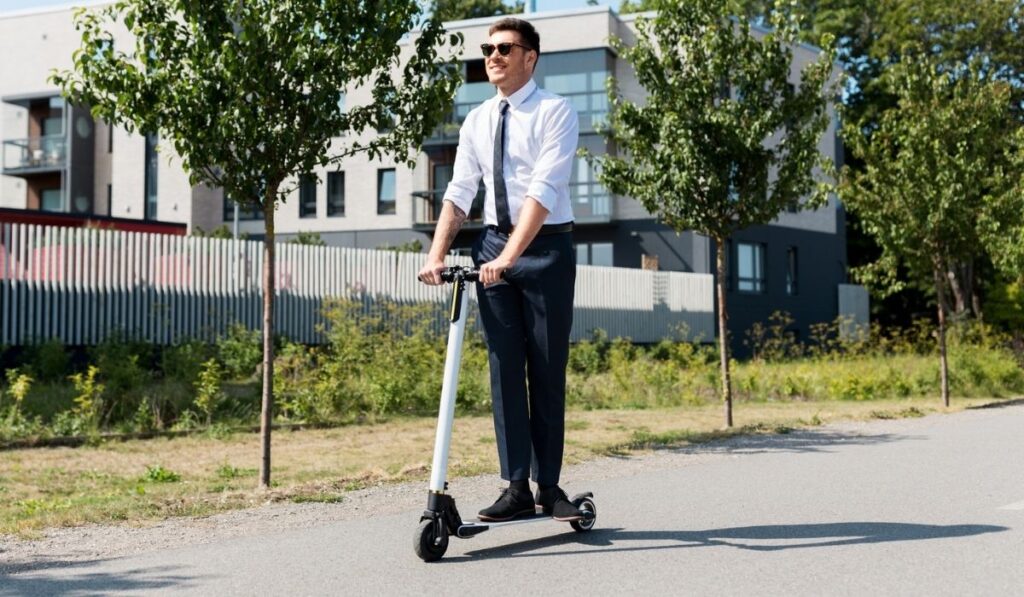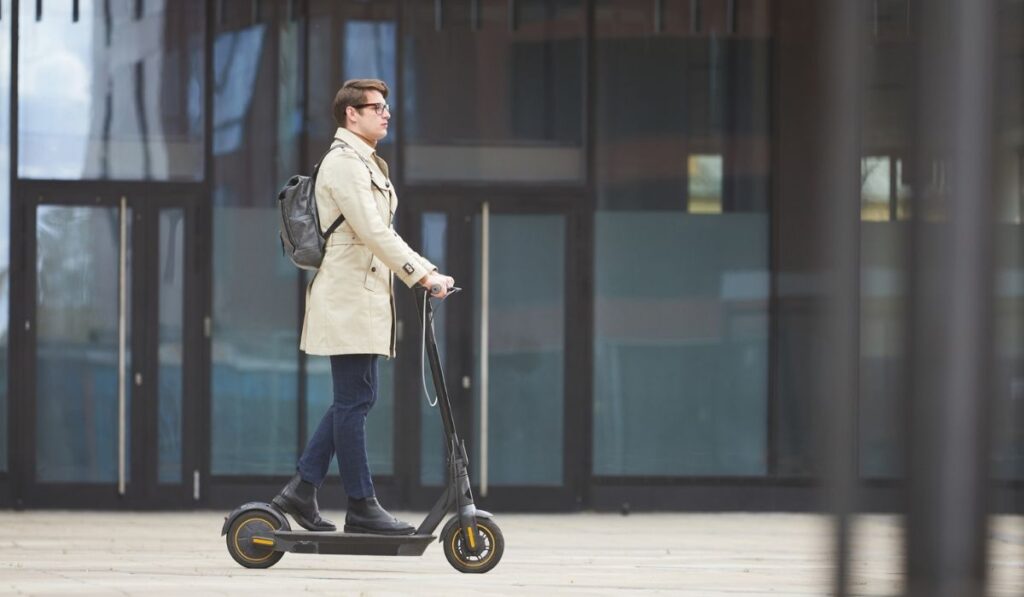Electric scooters have become an extremely popular form of transport! They allow riders to breeze through traffic congestion, not to mention being a joy to ride. E-scooters symbolize the ideal 21st-century mode of transportation not just for their lightweight and simple operation but also for their eco-friendliness.
You can ride an electric scooter manually without the battery, but most are designed to be powered by electricity. Scooters that are part of sharing networks like Bird or Lime will be locked when the power is dead, but if you own an electric scooter, you should be able to turn it off and ride it under your own power.
One of the greatest challenges with using your e-scooter as a push scooter is the risk of damage. Powering an electric scooter with no electricity is difficult, uncomfortable, and can also lead to eventual damage to the motor. But it’s a good thing that some manual-option electric scooters are available today.
Can You Ride an Electric Scooter Manually?

One great advantage of electric scooters is that they can operate with little to no effort. However, all these can turn around when the battery of your electric scooter runs out unexpectedly and your only option is to ride it manually.
By design, many electric scooters run on electricity. In most cases, it becomes a burden to operate them when you have to use another approach, such as leg power. Using your electric scooter manually won’t make it automatically blow up or stop working in the middle of the road, but you shouldn’t really expect a pleasant trip.
Hypothetically, you should be able to use your e-scooter manually. The design of most electric scooters is such that at a particular speed when riding, the electric motor is activated. On that note, electric scooters can operate on movement powered by your legs at a minimum.
Things become more complicated when the travel distance is longer. As mentioned previously, electric scooters are made to run on electrical power, not manual power from your legs.
More often than not, you will run out of battery, especially if your vehicle has been active for over a year at a stretch. While you will be able to carry it and drag it along to your destination, the possibility of actually pushing it around like a conventional scooter will be determined by your kind of vehicle.
There are vehicles that are operated manually and others that are 100% electrical. Dual or hybrid scooters are the cool new option these days because they can function either way, providing you with a swift and versatile way of commuting.
If you own a hybrid scooter, the issue of running out of juice will never be a problem since you always have the option of switching to manual mode so you can enjoy a conventional ride to your destination.
As a general rule, avoid changing from one mode to the other when there’s still some battery level in the vehicle and recharge it at every opportunity.
When You Might Need to Use Your Electric Scooter Manually
Whether you take occasional brief and fun trips to the grocery store on your scooter or your commute more frequently, a time may come when you will have to manually kick it or simply walk it home (more likely). Here are some likely scenarios:
- Dead Battery: This can be considered the most common reason for malfunctioning electric scooters. Modern electric scooters are fitted with high capacity and high-quality lithium-ion batteries, but after a while these will become exhausted and unable to keep your two-wheeler going.
- Slack Handlebar: Safety issues may arise in some electric scooter models due to minor design flaws. The handlebar folding mechanism gradually becomes loose over time. The right tools can easily fix this issue but if you’re riding when it happens, you will need to end the ride immediately.
- Faulty Electronics: The electronics configuration of an electric scooter is not too complex. Nevertheless, it may break down periodically and cause the scooter to malfunction. The scooter may become inoperable due to a system short-circuit caused by worn electric wires and water damage.
- Brake Issues: The brakes can lose their fitting, leaving you to push your scooter to be on the safe side. Any kind of vehicle with damaged brakes or no brakes is not fit for riding. Fortunately, it is very simple to adjust loosened brakes. All you need is the appropriate tools to get the job done.
Why Manual Use Isn’t Recommended for Electric Scooters
Electric scooters can be set in motion by kicking or pushing them manually, however, it is neither fun nor an easy process, unlike standard kick scooters. Here are some reasons why powering your electric scooter yourself might be less enjoyable.
Weight
Electric scooters are a lot heavier than conventional kick scooters. In fact, the mass of an average electric scooter is 12 to 15 kg, which can’t be said to be quite “light.” Pushing an electric scooter is way more difficult, partly because of its larger weight.
A few key components of an electric scooter contribute to the overall weight – the electric motor/motors, the high-power lithium-ion battery, and the alloy frame.
Unfortunately, the favorite features of users contribute to the weight of the scooter. A standard frame will be rather light compared to a durable heavy-duty one.
A heavy-duty electric motor (or motors in the case of some electric scooters with two) for higher speed and greater power will have a bigger weight compared to one with low power. The weight of a battery with a higher capacity for a longer travel range will also be considerably higher than one with low power and low capacity.
Large Wheels
Most electric scooters have relatively large wheels. Many models are in the size range of 8 to 10 inches. If, for instance, an electric scooter has 10-inch wheels and you stand on the base plate, then there will be a distance of at least 5 inches between your feet and the ground.
If you attempt to push the electric scooter manually, the distance between your feet will be 6 inches. For the first or first two kicks required to get this scooter going, such positioning may be overlooked, but you will get weak (especially in your knees) too quickly.
Electric Motor
The tires connect directly to the electric motor. Since the clutch or “neutral” feature is absent, the scooter cannot have free motion. An electric motor has an amount of resistance when it is not in operation.
Though the resistance is negligible for the first few times you try to push the scooter, it becomes heavier when the trips become longer.
How to Increase Your Electric Scooter Range

It is easy and cost-free to increase the range of an electric scooter. Fortunately, you can get a 50-mile travel distance on most modern models without charging.
Some also come with regenerative brakes (KERS) brakes. Through this technology, the battery is charged during the application of the brakes and can further increase the range.
There are several suggestions on how you can get the best range from your electric scooter. Check out a few of them.
1. Charging the Battery
As obvious as this sounds, if you forget to charge after returning from a long ride on your scooter, you might get upset the next day when it gets drained on your way to work.
2. Battery Maintenance
You will get a longer range and greater power out of a healthy battery. Lithium-ion batteries are generally optimized when the temperature is about 77°F or 25°C. Higher temperatures generally reduce the lifespan of the battery while lower temperatures will reduce the power capacity of the battery. Specifically, avoid extreme temperatures.
3. Checking the Tire Pressure
As is the case with cars, tire pressure affects the travel range. Every electric scooter model comes with unique specifications, so ensure you read the owner’s manual. Pressures for the front and back tires may be different and will depend on the weight of the rider. It is advisable to inspect the tire pressures every week.
4. Controlling Acceleration
Accelerating hard will overwork the battery the most, so take your electric scooter steady if you want to extend the range.
5. Using the Right Terrain
Going all the way uphill is not helpful, but you can freely roll downhill after! The ideal surface is a smooth tarmac as it has less resistance compared to a dirt track or grass.
6. Weight
Ensure that you’re not placing too much weight on your scooter as the range reduces with heavier weight.
7. Maintaining your scooter
Like with other mechanical devices, always keep your scooter’s parts neat, lubricated, and properly fitted for maximum performance and efficiency.
